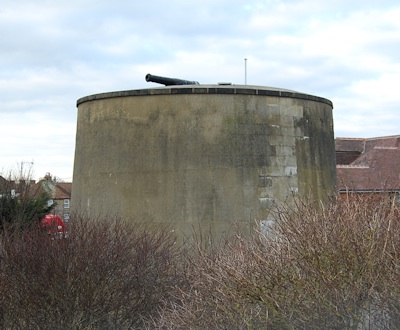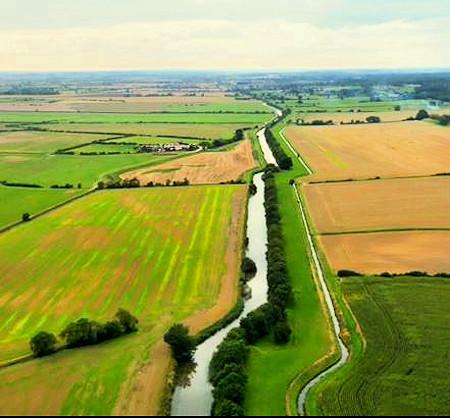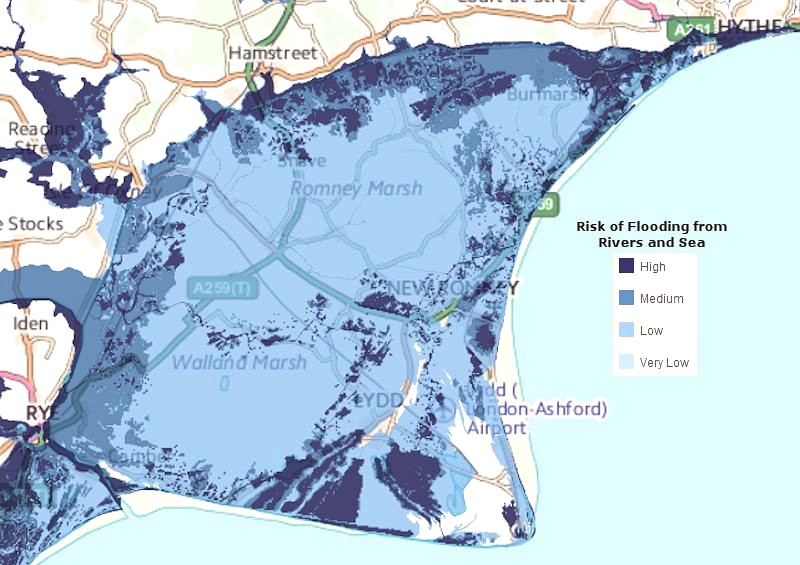Wars with the French
![]() News Item About the Threat of Invasion
News Item About the Threat of Invasion
from The Kentish Gazette 20th July 1804
![]() The impact of the Napoleonic Wars on the Romney Marsh
The impact of the Napoleonic Wars on the Romney Marsh
Defensive Measures Against the French
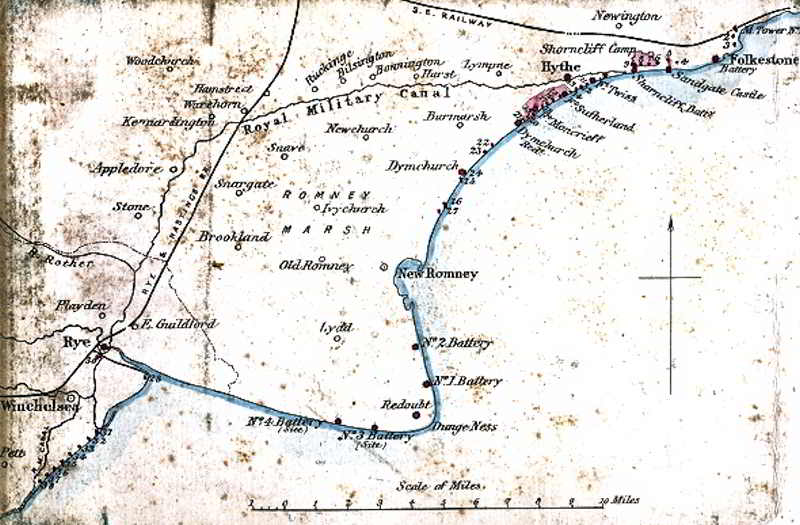
1867 map showing the Fortifications on the Romney Marsh coast. The nos 21 to 27 refer to Martello Towers
Napoleon Bonaparte, Emperor of the French from 1804, is best remembered for his role in the wars led against France by a series of coalitions, the so-called Napoleonic Wars. Due to his success in these wars, often against numerically superior enemies, he is generally regarded as one of the greatest military commanders of all time, and his campaigns are studied at military academies worldwide.
At the end of the 18th century the revolution in France had turned all of Europe into turmoil and Britain had become embroiled in war against France. After Napoleon had invaded the Low Countries in 1793, Britain feared we would be next, with Napoleon waging war against Britain from 1803 to 1815, when he was defeated by Wellington at the Battle of Waterloo.
Given this fear of an invasion, large scale construction projects were undertaken to provide defence to vulnerable coastline and Britain began planning a number of defensive measures across Romney Marsh to counter Napoleon's threat. These measures included the building of the Royal Military Canal, the Martello Towers and a number of gun Batteries/Forts on the coast at Dungeness and (present day) Lydd-on-Sea.
“All my thoughts are directed towards England.
I want only for a favourable wind to plant the Imperial Eagle on the Tower of London.”
Napoleon Bonaparte (1769-1821), also known as Napoleon I, was a French military leader and emperor who conquered much of Europe in the early 19th century. Born on the island of Corsica, Napoleon rapidly rose through the ranks of the military during the French Revolution (1789-1799). After seizing political power in France in a 1799 coup d’état, he crowned himself emperor in 1804. Shrewd, ambitious and a skilled military strategist, Napoleon successfully waged war against various coalitions of European nations and expanded his empire.
However, after a disastrous French invasion of Russia in 1812, Napoleon abdicated the throne two years later and was exiled to the island of Elba. In 1815, he briefly returned to power in his Hundred Days campaign. After a crushing defeat at the Battle of Waterloo, he abdicated once again and was exiled to the remote island of Saint Helena, where he died at 51.
Napoleon Bonaparte is regarded as one of the greatest commanders in history, his wars and campaigns are studied at military schools worldwide.
![]() reference and more information
reference and more information ![]() Biography of Napoleon Bonaparte
Biography of Napoleon Bonaparte
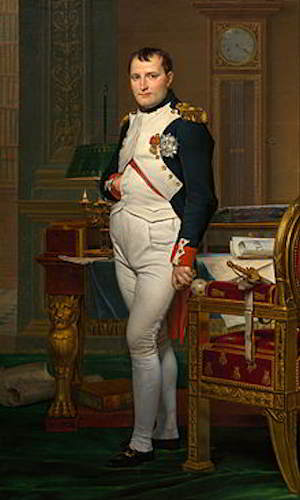
It was in 1793 that the first war began, which is known as the Revolutionary War. In July 1789 the Bastille in Paris was stormed by the mob. In 1791 King Louis fled, only to be recaptured and guillotined in 1793. The French revolutionaries declared war on all the monarchies of Europe, and invaded the Austrian Netherlands, declaring war on Britain on 1st February 1793. So started twenty-two years of conflict.
There was only a small British Army at the time and defence of the country mainly fell to the shoulders of the Navy. Even the Navy was not large; it grew from a peacetime size of 16,000 men to 100,000 by 1795. Nelson was at the time in charge of the Channel Fleet with fifteen ships of the line and fifty frigates.
At one point in 1801 there was a huge French Army across the Channel ready to invade and all volunteers ,were put on alert. Romney Marsh and the surrounding area became covered in large army camps full of both regular soldiers and the militias.
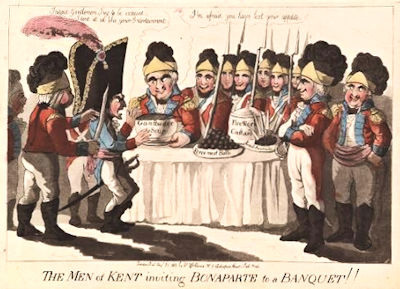
'The Men of Kent inviting Bonaparte to a banquet!!'
Larger Image
The fear of invasion was not entirely without foundation. In 1796 the French tried to land a force in Bantry Bay in Ireland and were only foiled by bad weather. Two years later they did succeed and 1,100 French troops landed in County Mayo where they were joined by some locals but not as many as they hoped and they were soon defeated.
In 1797 there was also a landing in Fishguard in Wales, which for some reason the French thought would also be an area where the locals would join them. Again they were disappointed and were soon defeated.
Dungeness Redoubt and its four batteries were built in 1798 to help defend the Kent coast against any possible invasion.
A Peace treaty was signed in 1802 at Amiens, giving breathing space to both powers. This however was not the end of the wars and by 1803, war had been renewed.
.jpg)
No. 2 Battery (Lade Fort) at Lydd-on-Sea
The fear of invasion after the outbreak of war again in 1803 was well founded. For some time Napoleon apparently intended to attack England, concentrating a force of 130,000 men and thousands of barges and small boats along the French coast.
![]() Napoleon’s Threatened Invasion of England 1803-1804
Napoleon’s Threatened Invasion of England 1803-1804
This led to a new wave of defensive buildings and in 1804 sites were surveyed for several Martello Towers lining the coast, with larger redoubts interspersed between them, one at Dymchurch. As well as the Martello Towers, the Royal Military Canal was constructed as a defence against the possible invasion of England during the Napoleonic Wars. The canal ran for 28 miles between Seabrook near Folkestone and Cliff End near Hastings, following the old cliff line bordering Romney Marsh.
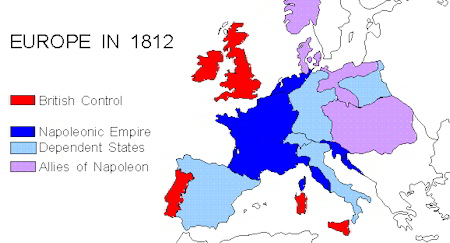
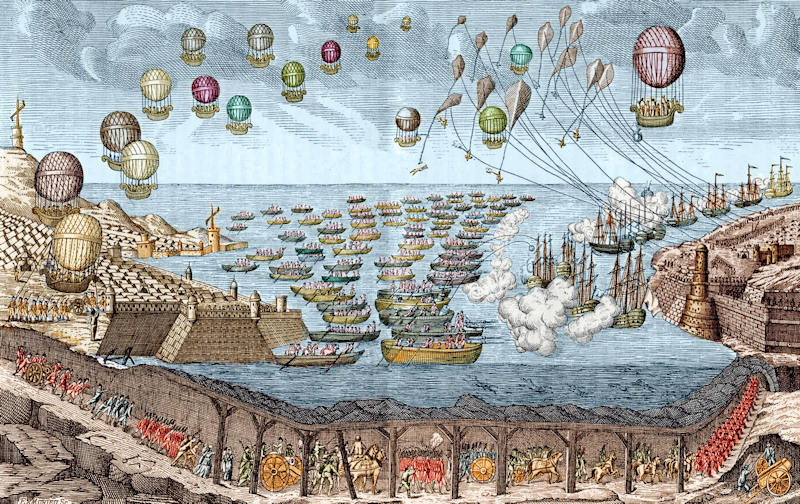
Up and Away Engraving imagines how Napoleon could invade England
The summer of 1805 is probably as near to full scale invasion that Britain had been since 1066. Napoleon's army was poised at Boulogne ready at 24 hours notice to invade and Napoleon believed that he had lured the British fleet away from the English Channel.
In August 1805, Napoleon ordered his Admiral Villeneuve, who commanded the French fleet, to "Sail, do not lose a moment, and with my squadrons reunited enter the Channel. England is ours We are ready and embarked. Appear for twenty-four hours, and all will be ended" But Viileneuve had been attacked by the British Navy and he sought save haven in Cadiz. When he did emerge, he was defeated at the Battle of Trafalgar on 21 October 1805.
After the Battle of Trafalgar, Napoleon continued to wage war across Europe for another ten rears. Until his final defeat at Waterloo in 1815, Britain could not rest and the threat of renewed invasion attempts was ever present. Indeed, during 1811, the Emperor briefly flirted with the idea of restoring his invasion fleet. But after hsi defeat at Moscow in 1812,the idea was never spoken of again.
The building of the Martello Towers and the Royal Military Canal continued well after French invasion army left Boulogne, with the last of the south coast towers, of which there were 74, being completed in 1810. The Royal Military Canal was completed in 1809, although by the summer of 1806 there was a 19 mile stretch of the canal from Hythe to Iden. Only six Martello Towers had been built by that time, however.



















